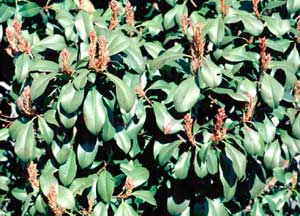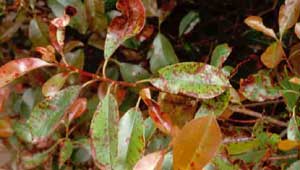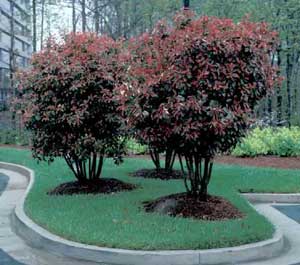Landscape Shrubs
Fraser Photinia; Redtip Photinia
(Photinia x fraseri)
Redtip photinia (Photinia x fraseri) would be easily recognized by everyone as one of the most common broadleaf evergreen hedge or screen plants used in Arkansas. The justification for using this plant is easily recognized when you consider the lovely fire-red new growth, the aggressive upright oval growth habit, and absence of foul-smelling flowers typical of the species.
In other parts of the country this is a great plant, but not in Arkansas. For some reason the combination of temperatures and humidity in Arkansas make this plant incredibly susceptible to an aggressive fungal leaf spot (Entomosporium). The Cooperative Extension Service has an excellent fact sheet on this disease (http://www.uaex.uada.edu/publications/PDF/FSA-6112.pdf). In many other parts of the country where this plant grows, you will not see leaf spot as a threat. Concerted foliar sprays in early spring can minimize this problem, but that approach is really not practical. The best solution is to consider alternatives to this commonly available broadleaf evergreen plant.
You don’t have to look far to find some suitable alternatives. Two other species of Photinia (P. serrulata and P. glabra) are noticeably less susceptible to leaf spot. However, there are some tradeoffs. Chinese photinia (P. serrulata), while nearly free of leaf spot, differs from redtip in that it is a much larger plant (20’ x 20’), more rounded in habit, does not have the attractive fire red foliage, and is covered with noticeably odiferous flowers in late March/early April. The smelly flowers are only an issue for two weeks out of a year, but this is likely why gardeners have shied away from this plant. Interestingly enough, Chinese photinia is the seed parent for the redtip photinia hybrid. Chinese photinia tend to be located on older landscapes that pre-date the introduction of redtip. One positive landscape attribute is the dramatic red fruits that follow the flowers. If you are in doubt about whether you are looking at a Chinese photinia or not, check the edge of the leaf. The leaf margin is distinctly serrated, like teeth on a saw blade. Chinese photinia will be much harder to find at a garden center.
The Japanese photinia (P. glabra) is a closer approximation of redtip. The overall plant size (14’ x 14’) is between the Chinese and redtip, the emerging foliage color is almost as bright as redtip, and there may be a smidge fewer flowers on the Japanese compared to the Chinese photinia. Regrettably, susceptibility to leaf spot on Japanese photinia is somewhere between Chinese and redtip. Japanese photinia flowers about two weeks later (mid-April) than the Chinese.
Cultural requirements for either photinia are similar. These plants are pretty darn tough and adaptable to most soils and exposures. Photinia plants will be more open (less dense) and more susceptible to leaf spot fungus when grown in dense shade, however.
- Common Name: Chinese and Japanese photinia
- Varieties to look for: none
- Flower Color: white/cream
- Blooming period: late March to mid-April
- Perennial or annual: woody perennial
- Size: 15’ tall by 15’ wide
- Exposure: full to partial sun
- Soil: adaptable
- Watering: tolerates dry
- When to prune: anytime
- When to fertilize: spring or fall
- Suggested use: hedge or screen
Leaves and red tips

Leaves with affects of leafspot disease

Form
